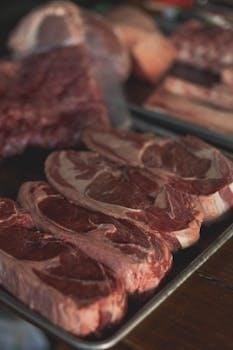beginner carnivore diet meal plan pdf

Carnivore Diet Meal Plan for Beginners⁚ A Comprehensive Guide
Embarking on the carnivore diet can feel overwhelming initially. This comprehensive guide simplifies the process. We provide a structured approach. Learn how to create a beginner-friendly meal plan. Discover tips for success. Navigate the dietary landscape with confidence. Prioritize nutrient-dense animal products. Optimize your health. Achieve your goals effectively.
Understanding the Carnivore Diet
The carnivore diet, a subset of ancestral eating, primarily focuses on consuming animal products. It eliminates plant-based foods entirely, a seemingly restrictive approach. However, understanding its core principles reveals a unique nutritional strategy. Proponents argue that animal-based foods offer sufficient nutrients for optimal health, challenging common misconceptions about dietary needs. This dietary approach can be tailored to individual preferences, with some incorporating dairy or organ meats for enhanced nutrient intake.
Differentiating between strict adherence and flexible adaptations is essential. The carnivore diet’s potential benefits, such as weight loss and reduced inflammation, have garnered attention, but individual health needs should always be considered. Consulting with healthcare professionals is recommended before starting this diet. By grasping these aspects, one can navigate the carnivore diet effectively. Avoid common pitfalls, and make informed decisions aligned with personal wellness goals; This understanding forms the bedrock for a successful carnivore journey.
Principles of the Carnivore Diet
The carnivore diet operates on several fundamental principles. First and foremost is the elimination of all plant-based foods. This includes fruits, vegetables, grains, legumes, nuts, and seeds. The diet centers around animal products like meat, fish, poultry, eggs, and some dairy. A primary goal is to reduce inflammation and promote overall health by consuming nutrient-dense foods that are easily digestible. High protein and fat intake are hallmarks of this diet, leading to ketosis, where the body burns fat for fuel.
Emphasis is placed on sourcing high-quality animal products, such as grass-fed beef and wild-caught fish, to maximize nutrient content and minimize exposure to toxins. Minimizing processed foods and additives is also key. Meal planning focuses on simplicity, with meals often consisting of a single animal-based food or a combination of a few. Individual experimentation and adjustments are encouraged to tailor the diet to specific needs and preferences. Listening to one’s body and making necessary modifications is crucial for long-term success and sustainability.
Foods Allowed on the Carnivore Diet
Adhering to the carnivore diet involves a strict selection of animal-based foods. The cornerstone of this diet is meat, encompassing various types such as beef, lamb, pork, chicken, turkey, and game meats like venison. Fish and seafood are also permitted, including options like salmon, tuna, shrimp, and crab, providing essential fatty acids and minerals. Eggs from any source, whether chicken, duck, or quail, are a versatile and nutritious addition, offering protein and healthy fats.
Certain dairy products, such as butter, ghee, and some hard cheeses, are sometimes included, depending on individual tolerance and dietary goals. Organ meats, including liver, kidney, and heart, are highly encouraged due to their exceptional nutrient density, providing vitamins and minerals often lacking in muscle meats. Bone broth, rich in collagen and electrolytes, can also be incorporated. The focus remains on unprocessed, whole animal foods, ensuring optimal nutrient intake while eliminating plant-based sources.

Benefits of the Carnivore Diet
The carnivore diet offers nutritional simplicity. It streamlines meal planning effectively. Many experience weight loss. Body composition improves noticeably. Inflammation reduces significantly. Understanding these advantages helps. Determine if this aligns with goals. Enhance eating habits. Achieve better health outcomes.
Nutritional Simplicity and Meal Planning
Embracing the carnivore diet delivers remarkable nutritional simplicity, making meal planning straightforward and stress-free. With a focus solely on animal products, you eliminate the complexities often associated with balancing macronutrients from various food groups. This streamlined approach means you can easily plan your meals without the need for extensive calorie counting or complicated recipes.
The nutrient density of animal foods is another significant advantage. Foods like beef, chicken, and fish are packed with essential vitamins and minerals, providing you with the nutrition your body craves. By focusing on high-quality meats, youre ensuring that your meals are not only satisfying but also rich in nutrients. This can simplify your meal preparation, as you can quickly cook a variety of proteins without worrying about side dishes or additional ingredients.
Moreover, the carnivore diet reduces food choices, which can help eliminate decision fatigue. When your meals primarily consist of meats and animal products, you spend less time pondering what to eat. Overall, the nutritional simplicity of the carnivore diet makes it an efficient and effective option for those looking to enhance their eating habits.
Potential for Weight Loss
One of the standout advantages of the carnivore diet is its potential for weight loss. When you change to this diet, you may experience significant metabolic changes. By eliminating carbohydrates, your body shifts to burning fat for fuel, a process known as ketosis. This can lead to more efficient fat loss and a decrease in body weight.
Additionally, the carnivore diet emphasizes protein intake, which plays an essential role in appetite regulation. High-protein meals can help you feel full longer, reducing the urge to snack or overeat. Research shows that protein-rich diets can lead to a decrease in overall calorie consumption, making it easier for you to adhere to your weight loss goals.
Moreover, since the carnivore diet focuses solely on animal products, it simplifies food choices, which can help you stick to your plan without the distractions of processed foods. While some may find the restrictive nature challenging, many report that this simplicity ultimately supports their commitment to weight loss. Overall, if youre looking for a straightforward approach to weight loss, the carnivore diet might be worth considering.
Reduction in Inflammation
Many followers of the carnivore diet report experiencing reduced inflammation, which can greatly enhance overall health and well-being. The diet, rich in animal-based foods, is believed to have strong anti-inflammatory properties, helping combat chronic pain and other inflammatory conditions. By eliminating foods that can trigger inflammation, like grains and processed sugars, you may find relief from discomfort and improved mobility.
Heres a closer look at how the carnivore diet can impact inflammation⁚
- Elimination of Inflammatory Foods⁚ By cutting out plant-based foods, you avoid common allergens and irritants.
- Nutrient-Rich Animal Products⁚ Animal foods provide essential nutrients that support the body’s natural healing processes.
- Gut Health Improvement⁚ The diet can help balance the gut microbiome, reducing gut-related inflammation.
Research indicates that the nutrients found in animal products, such as omega-3 fatty acids and certain amino acids, contribute to these anti-inflammatory effects. While individual experiences may vary, many who adopt this diet report a significant reduction in inflammation-related issues, paving the way for a healthier lifestyle. If you struggle with chronic pain or inflammation, the carnivore diet might be worth considering as a potential solution.

Building a Carnivore Diet Meal Plan
Crafting a carnivore diet meal plan involves strategic food choices. Prioritize high-quality animal products. Incorporate nutrient-rich organ meats. Understand healthy fat sources. A well-structured plan ensures nutritional completeness. It also supports adherence. Simplify your meal planning. Optimize your carnivore diet success through informed choices.
Prioritizing High-Quality Animal Products
When embarking on a carnivore diet, the quality of your animal products is paramount. Focus on sourcing high-quality meats, including beef, lamb, pork, poultry, and fish, to maximize nutritional benefits. These proteins provide essential amino acids and vital nutrients such as B12, iron, and zinc, crucial for overall health and muscle maintenance.
Opt for grass-fed and pasture-raised meats whenever possible. These options typically offer a better fatty acid profile, with a higher concentration of omega-3 fatty acids and a more favorable omega-6 to omega-3 ratio. This can contribute to reduced inflammation and improved cardiovascular health.

Furthermore, consider the sourcing practices of your chosen products. Support local farmers and producers who prioritize animal welfare and sustainable farming methods. This ensures that the animals are raised in humane conditions and that the meat is free from unnecessary hormones and antibiotics.
By prioritizing high-quality animal products, you’re not only nourishing your body with essential nutrients but also supporting ethical and sustainable practices. Making informed choices about your food sources sets a solid foundation for a successful and health-conscious carnivore diet journey.
Incorporating Organ Meats and Healthy Fats
To optimize your carnivore diet, incorporate organ meats and healthy fats strategically. Organ meats, such as liver, kidney, and heart, are nutritional powerhouses. They offer concentrated doses of essential vitamins and minerals, including vitamin A, vitamin D, iron, and copper. These micronutrients are vital for various bodily functions, supporting energy levels, immune health, and overall vitality.
Introduce organ meats gradually into your diet. Start with small portions to assess your tolerance and preference. You can blend them into ground meat dishes or prepare them as standalone meals. Experiment with different cooking methods to find what works best for you.
Alongside organ meats, prioritize healthy fats from animal sources. Fatty cuts of meat, like ribeye and pork belly, provide essential fatty acids crucial for hormone production, nutrient absorption, and satiety. Include tallow, lard, and bone marrow in your cooking to enhance flavor and increase fat intake.
Balance your fat intake with your activity level. Adjust portion sizes based on your energy needs and individual response. By thoughtfully incorporating organ meats and healthy fats, you’ll ensure a well-rounded and nutrient-dense carnivore diet that supports optimal health and performance.
Sample Meal Plan for Beginners
To simplify your start on the carnivore diet, consider this sample meal plan. It’s designed for beginners. It focuses on ease of preparation. It includes nutrient-dense animal products.
Breakfast⁚ Scrambled eggs cooked in butter. Add bacon or sausage for extra protein and fat; A simple, satisfying way to begin your day. It provides sustained energy.
Lunch⁚ Ground beef patties. Season them with salt and pepper. Serve with a side of bone marrow for added nutrients. This meal is quick to prepare. It is packed with essential amino acids.
Dinner⁚ Ribeye steak cooked to your preference. Pair it with a small portion of liver. Incorporate beef tallow for cooking. This meal is rich in healthy fats. It delivers vital micronutrients.
Snacks⁚ Beef jerky, pork rinds, or hard-boiled eggs. These options are convenient and portable. They help manage hunger between meals; They ensure consistent protein intake.
Remember to adjust portion sizes. Adapt this plan to your individual needs. Stay consistent with your choices. Monitor how your body responds. By following this sample plan, you can successfully navigate the initial stages of the carnivore diet.

Tips for Success on the Carnivore Diet
Succeeding on the carnivore diet involves planning. Prioritize meal preparation for convenience. Embrace a positive mindset for consistency. Listen to your body’s signals carefully. Stay hydrated to support overall health. Experiment with various animal products. Seek support from carnivore communities online. Adjust as needed for long-term adherence.
Meal Preparation and Planning
Mastering meal preparation is crucial for carnivore diet success. Planning ahead eliminates impulsive choices. Dedicate time each week to cook. Portion your meals for grab-and-go ease. Start by creating a shopping list. Focus on high-quality animal products. Include a variety of meats to avoid boredom.
Consider cooking large batches. This reduces daily cooking time. Ground beef, roasts, and whole chickens are great options. Store meals in airtight containers for freshness. Keep snacks like beef jerky on hand. This prevents hunger pangs between meals.
Embrace simplicity in your cooking. Season meats with salt and pepper initially. As you adapt, explore other carnivore-friendly spices. Learn basic cooking methods like grilling and roasting. These methods preserve flavor and nutrients.
Keep a food journal. Track your meals and how they make you feel. This helps identify any potential sensitivities. Adapt your meal plan based on your body’s feedback. With diligent meal preparation and planning, the carnivore diet becomes sustainable.




